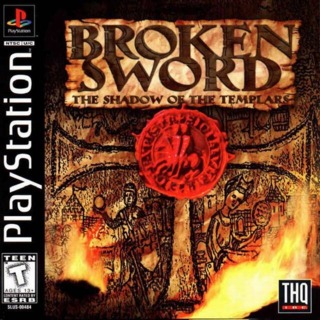Handheld Adventure Gaming Defined
You play as an American in Paris named George Stobbart, enjoying your vacation outside of a French cafe. While relaxing and enjoying the scenery, an odd man dressed as a clown enters the cafe and scuffles off in a hurry. The cafe explodes, and the mystery begins. George eventually learns that the incident is linked to a modern version of an ancient organization called the Knights Templar, and a plan to take over the world. George will travel several European countries and locations in the Middle East, having discussions with some very cleverly scripted and drawn characters, with some clues in their comical banter. He'll solve some puzzles, which are by no means simple, but aren't so taxing as to put off the grey-matter-imparied. Among the characters, George will meet a cute French reporter who becomes George's love-interest throughout the "Broken Sword" series. The story is unique and engaging, but Revolution Software didn't stop there, providing a game that is really enhanced by the very-well-drawn classical cartoonish backgrounds, well-done animation for character movement, and an incredibly charming musical score. This Gameboy Advance port of the game has been painstakingly modified so that the backgrounds and animation from the PC-original will not lose anything visual clarity, and the work has really paid off, with most of the scenes both recognizable, and seen in an entirely new light, with fluid animation against lush backgrounds. The same can't be said of the incidental music. The original PC game, and the Playstation port, had some of the best mood music in any game, and some of it remains in the GBA game. I can't tell whether my reaction to it is due to the nature of the system itself, or the music is actually less than it was in those releases, but something definitely seems to be missing. The voice-work is also a casualty, and this is perhaps the most significant loss in the port. The dialog however is as witty and clever as it was before, and with a little imagination, gamers will be able to make up for the loss of the voicework.
Two-dimensional adventure games often-times use point-and-click interfaces of various varieties, and this game is no exception. However, the design of this particular interface is where this game really shines. Most adventure game systems around this time have either very limited options, or complex control schemes, both in activity and dialogue. The developers of this game created an interface in which new clues and information are kept in one inventory, while items discovered are kept in another inventory. When entering into dialog with another character in the game, both of these inventories appear. This gives the game a real sense of non-linear discovery, though perhaps artificial. You must find certain clues, items, or information, before such dialogue options will open with each character. That the game tracks these discoveries makes the appearance of new options at other points in the game a step above some of the non-sequitur changes experienced in other adventure games. Backtracking becomes part of the game, but unlike other adventure games, it doesn't really feel like backtracking, because the sense of discovery along with the dramatically unfolding storyline, keep the game from feeling contrived or stagnant, and unlike some adventure games, it is possible to die based on unwise decisions made during the game.
This interface was not as succesfully ported over to the Playstation release, and it looks like Revolution Software really listened to the criticisms of that port, and worked hard not to make the same mistakes again. However, there are still significant bugs in the game that can literally block the gamer from progressing. These bugs are nowhere near as crippling as those found in the Playstation release, and do have solid workarounds, but they can be annoying nonetheless. Other than this unfortunate reminder of the past, this Gameboy Advance port does an amazing job of presenting the original PC-layout in a more-limited handheld environment, without sacrificing the functionality. I am frankly amazed at how much detail fits onto the significantly smaller Gameboy Advance screen.
Revolution Software literally introduced a renaissance in the adventure genre with the original release of this game. Its perhaps the best-known game in that genre, and few games since have so fully reinvented adventure gaming as we know it. This game is my favorite in that genre, in any of its various platform releases, and I am not the only one who recognizes it as such. That is perhaps the best testament to this game's ongoing popularity, in that its fans have never forgotten the lesson of what is possible, and keep waiting for other developers to raise the bar. To have it available on a handheld system is, I hope it, a hint at things to come. Some of the newer handheld systems, particularly the Nintendo DS, are so well suited to this type of point-and-click adventure game, that it would be a travesty of justice for Revolution not to take advantage of it. Here's to hoping a new 2D adventure in the "Broken Sword" series will grace our handhelds in the near future.

